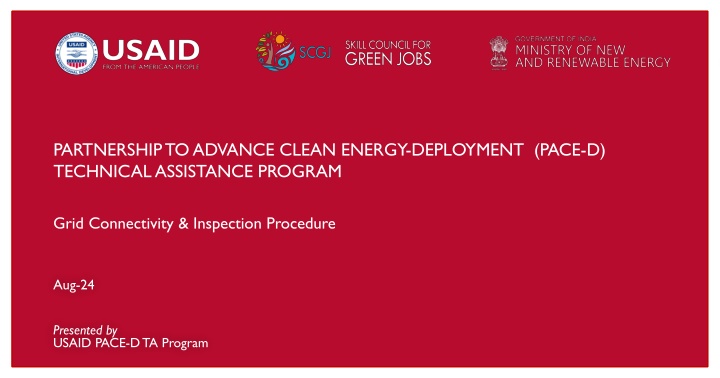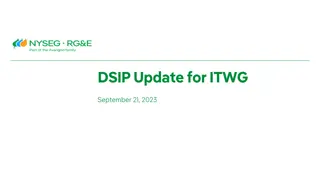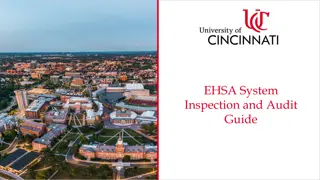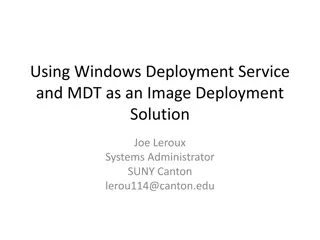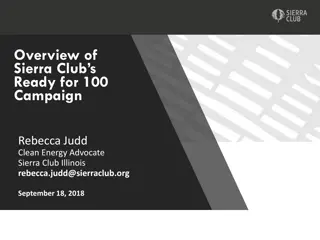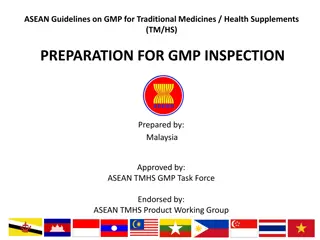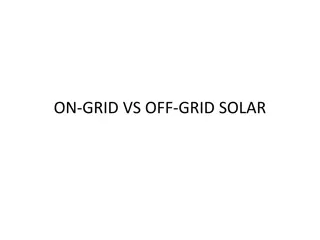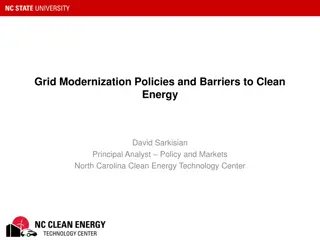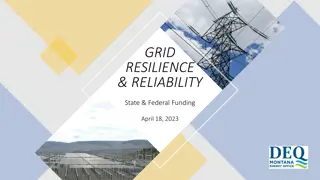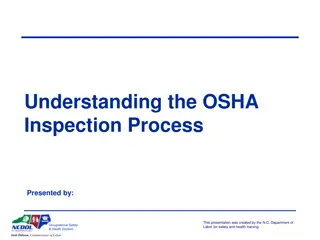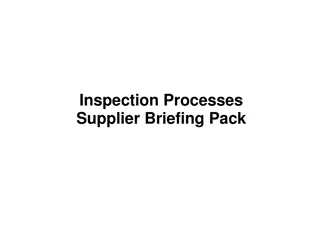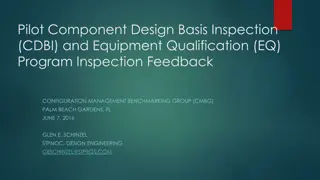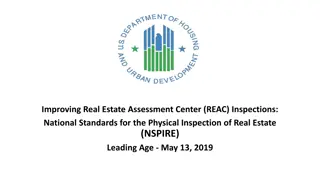Partnership to Advance Clean Energy Deployment (PACE-D) Technical Assistance Program Grid Connectivity & Inspection Procedure
The Partnership to Advance Clean Energy Deployment (PACE-D) Technical Assistance Program, presented by USAID, focuses on grid connectivity and inspection procedures for clean energy deployment. Sessions cover applicable standards, regulations, interconnection tests, net metering systems, and more. Relevant standards and technical requirements are highlighted, including monitoring provisions and synchronization voltage regulations for distributed resources.
Download Presentation

Please find below an Image/Link to download the presentation.
The content on the website is provided AS IS for your information and personal use only. It may not be sold, licensed, or shared on other websites without obtaining consent from the author.If you encounter any issues during the download, it is possible that the publisher has removed the file from their server.
You are allowed to download the files provided on this website for personal or commercial use, subject to the condition that they are used lawfully. All files are the property of their respective owners.
The content on the website is provided AS IS for your information and personal use only. It may not be sold, licensed, or shared on other websites without obtaining consent from the author.
E N D
Presentation Transcript
PARTNERSHIP TO ADVANCE CLEAN ENERGY-DEPLOYMENT (PACE-D) TECHNICAL ASSISTANCE PROGRAM Grid Connectivity & Inspection Procedure Aug-24 Presented by USAID PACE-D TA Program
Session: Contents Applicable standards and regulations for grid connectivity of SPVRT Interconnection technical specifications and requirements Component inspection checklist Grid connected functional safety checklist
Session: Contents Interconnection test specifications and requirements Commissioning tests Unintentional islanding functionality test Periodic interconnection tests
Net Metering System with Battery Battery Bank To dedicated consumer loads
Applicable Standards & Regulations for Grid Connectivity of SPVRT Central Electricity Authority (Technical Standards for Connectivity of the Distributed Generation Resources) Regulations 2013 IEEE 1547 Standard for Interconnecting Distributed Resources with Electric Power System, 2003 Central Electricity Authority (Measures Relating to Safety and Electricity Supply) Regulations, 2010 Central Electricity Authority (Technical Standards for Connectivity to the grid) Regulations 2007 IEEE 519: Recommended Practice and Requirements for Harmonic Control in Electric Power Systems, 2014
Interconnection Technical Specifications & Requirements General Requirements (IEEE 1547 / CEA Regulation 2013) Monitoring Provision Synchronization Voltage Regulations Each distributed resource of 250 kVA or more at a single point of interconnection shall have provisions for monitoring its connections status, real power output, reactive power output and voltages at the point of interconnection The distributed resource synchronized with electric system shall not cause a voltage fluctuation at the point of interconnection greater than 5% The distributed resources shall not actively regulate the voltage at the point of interconnection
Interconnection Technical Specifications & Requirements General Requirements (IEEE 1547 / CEA Regulation 2013) Isolation Device There should be a manually operating isolating switch between distributed generation resource and electric system, which meets the following requirements: Allow visible verification that separation has been established Indicators to show clearly closed and open position Be readily accessible and be capable of being locked in open position May not be rated for load-break Be located at height of 2.44 m above ground level
Interconnection Voltages Depends on state grid code / SERC regulation Normal capacities and voltages: Capacity < 4 kW (or 5 / 6 / 7 / 10 kW in some states) connected at 240 VAC, 1 , 50 Hz Capacity > 4kW (or 5 / 6 / 7 / 10 kW in some states) but < 50 kW (or 75 / 100 / 112 kW in some states) connected at 415 VAC, 3 , 50 Hz Capacity > 50 kW (or 75 / 100 / 112 kW in some states) < 1 MW (or 2 / 3 / 4 / 5 MW in some states) connected at 11 kVAC, 3 , 50 Hz *The above mentioned ranges normally fall under grid codes for respective states
Interconnection Parameters - 1 Parameters Reference Requirement Overall Grid Standards Central Electricity Authority (Grid Standard) regulations 2010 Compliance Equipment BIS / IEEE / IEC Compliance Central Electricity Authority (Installation and Operation of Meters) Regulation 2006& Amendments thereof, OERC Generic Tariff Order 2013 Meters Compliance Central Electricity Authority (Measures of Safety and Electricity Supply) Regulation 2010 Safety and Supply Compliance IEEE 519 and CEA (Technical Standards for Connectivity of the Distributed Generation Resources) Regulations 2013 shall not exceed the limits specified in IEEE 519 Harmonic Current
Interconnection Parameters - 2 Parameters Reference Requirement IEEE 519 and CEA (Technical Standards for Connectivity of the Distributed Generation Resources) Regulations 2013 Every time the generating station must be synchronized to the grid. Voltage fluctuation < 5% at point of inter connection Synchronization IEEE 519 and CEA (Technical Standards for Connectivity of the Distributed Generation Resources) Regulations 2013 Voltage-operating window should be under operating range of 80% to 110% of the nominal connected voltage. Beyond a clearing time of 2 second, the photovoltaic system must isolate itself from the grid Voltage IEEE 519 and CEA (Technical Standards for Connectivity of the Distributed Generation Resources) Regulations 2013 Should not cause voltage flicker in excess of the limits stated in IEC 61000 Flicker
Interconnection Parameters - 3 Parameters Reference Requirement IEEE 519 and CEA (Technical Standards for Connectivity of the Distributed Generation Resources) Regulations 2013 When the Distribution system frequency deviates outside the specified conditions (50.5 Hz on upper side and 47.5 Hz on lower side), there should be over and under frequency trip functions with a clearing time of 0.2 seconds. Frequency IEEE 519 and CEA (Technical Standards for Connectivity of the Distributed Generation Resources) Regulations 2013 Should not inject DC power more than 0.5% of full rated output at the interconnection point DC injection IEEE 519 and CEA (Technical Standards for Connectivity of the Distributed Generation Resources) Regulations 2013 While the output of the inverter is greater than 50%, a lagging power factor of greater than 0.9 should operate Power Factor
Interconnection Parameters - 4 Parameters Reference Requirement IEEE 519 and CEA (Technical Standards for Connectivity of the Distributed Generation Resources) Regulations 2013 In the event of fault, voltage or frequency variations the PV system must island / disconnect itself within IEC standard on stipulated period Islanding and Disconnection IEEE 519 and CEA (Technical Standards for Connectivity of the Distributed Generation Resources) Regulations 2013 The inverter should have the facility to automatically switch off in case of overload or overheating and should restart when normal conditions are restored Overload and Overheat IEEE 519 and CEA (Technical Standards for Connectivity of the Distributed Generation Resources) Regulations 2013 Paralleling device of photovoltaic system shall be capable of withstanding 220% of the normal voltage at the interconnection point. Paralleling Device
Component Inspection Checklist Sr. No. Item type Yes No 1 Installation Layout is it as per drawing? 2 Inverter IS / IEC standards qualified 3 PV panel IS / IEC standards qualified 4 PV isolators / PV cables IS / IEC standards qualified String level and cumulative protections are provided for over-current and surges 5 6 AC disconnect manual switch provided with locking arrangement 7 Meters approved by concerned authority
Grid Connected Functional Safety Checklist Sr. No. Item type Yes No Check whether solar power generation stops automatically when DISCOM supply shut off 1 2 Confirm Bi-directional flow recorded on net meter 3 Check Consumption (Import) only mode operation 4 Check operation of Solar (Generation) meter 5 Check all Protections and Earthing points Confirm Solar and Bi-directional meter tested & sealed by DISCOM meter testing lab 6
Commissioning Tests All commissioning tests shall be performed based on written test procedures of equipment manufacturer / system integrator A visual inspection shall be made to ensure that the system earthing is adequate as per standard / regulation A visual inspection shall be made to confirm the presence of the isolation device as required by standard / regulation The following initial commissioning tests shall be performed on the installed solar PV rooftop system and grid connected inverter prior to the initial parallel connection to the grid: Operability test on the isolation device Unintentional islanding functionality Cease to energize functionality
Unintentional Islanding Functionality Test This test must be conducted during noon time on a sunny day SPVR system should produce more than 20% of the rated output of the SPVRT Array or the inverter whichever is less If there is more than one inverter, tests should be carried out for each inverter
Unintentional Islanding Functionality Test Test 1 Test 1: Inverter must cease supplying power within 0.2 seconds of loss of mains Step 1: Keep DC supply from the SPVRT array connected to the inverter Step 2: Place the voltage probe in the inverter side of the AC main switch Step 3: Turn OFF the main switch, through which inverter is connected to grid Step 4: Measure time taken for inverter to cease attempting to export power with a timing device and record
Unintentional Islanding Functionality Test Test 2 Test 2: Inverter must not resume supplying power until mains have been present for more than 60 seconds Step 1: Keep DC supply from the SPVRT array connected to the inverter Step 2: Place the current probe in the inverter side of the AC main switch Step 3: Turn ON the main switch, through which inverter is connected to grid Step 4: Measure time taken for inverter to re-energize and start exporting power with a timing device and record
Periodic Interconnection Tests All interconnection related protective functions and associated batteries shall be periodically tested at intervals specified by the manufacturer, system integrator or the authority who has the jurisdiction over the DR interconnection Periodic test reports should be maintained
Disclaimer: This training material is made possible by the support of the American People through the United States Agency for International Development (USAID). The contents of this material are the sole responsibility of Nexant, Inc. and do not necessarily reflect the views of USAID or the United States Government. This material was prepared under Contract Number AID-386-C-12-00001. Anurag Mishra Senior Clean Energy Specialist USAID/India Email: amishra@usaid.gov 25
